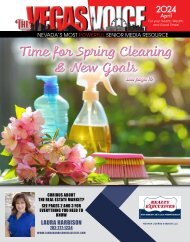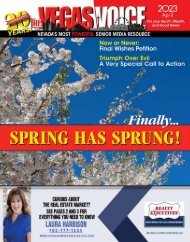You also want an ePaper? Increase the reach of your titles
YUMPU automatically turns print PDFs into web optimized ePapers that Google loves.
Time to Complete Your Garden<br />
By: Howard Galin / Happy Gardening<br />
In <strong>May</strong>, we have the opportunity to spend a<br />
great deal of time completing any remaining<br />
activities needed for a successful growing season.<br />
If you are planning on adding any plants or perhaps adding raised<br />
beds to your landscape, you may need to add additional “soil” to your<br />
garden. This leads to the question: “Is there a difference between<br />
garden soil and potting soil and are<br />
they interchangeable?”<br />
There is a difference and they are<br />
NOT interchangeable!<br />
Usually, potting soil is not soil at all,<br />
but is made up of organic materials<br />
that are mixed with chemical<br />
additives necessary for plant growth.<br />
It is primarily used in indoor pots and certain decorative planters<br />
around your garden.<br />
Garden soil is “real soil” that is rich in organic materials and<br />
biological activity that has been augmented with compost to retain<br />
moisture. Whether using potting soil (indoors) or garden soil in<br />
your garden, make certain that you “solar sterilize” by placing the<br />
unopened bags of soil in direct sunlight outdoors for a full day. The<br />
sun will heat the soil to about 160 F killing off all insect eggs and<br />
organisms.<br />
Outdoors, if you are going to add organic mulch to your soil,<br />
first apply a layer of diatomaceous soil to inhibit infestation of<br />
“exoskeleton” insects in your garden.<br />
With the exception of Palms, <strong>May</strong> through early June is the last time<br />
to apply fertilizer to your landscaping since you do not want to stimulate<br />
delicate plant growth that can be damaged by high temperatures and<br />
direct summer sun. Check for yellowing leaves which can be caused<br />
by iron deficiency (Chlorosis) and<br />
apply chelated iron when needed.<br />
As a “proactive” measure, you<br />
should apply systemic insecticide<br />
to the soil around the root areas to<br />
prevent insects. For visible insect<br />
infestation, treat with any “contact”<br />
insecticide.<br />
Follow the Summer irrigation schedule setting timers to a pre-dawn<br />
and/or post sunset start time with a 30 minutes run time. Frequently<br />
check drip/bubble emitters for proper location and for blockage and<br />
reposition and/replace where necessary.<br />
Have a gardening question? Contact me: Theplantwhisperer28@<br />
gmail.com.<br />
Howard Galin is a University of Nevada certified Master<br />
Gardener who lectures on, and writes about native plants and<br />
desert landscaping<br />
36<br />
<strong>May</strong> <strong>2024</strong>
















